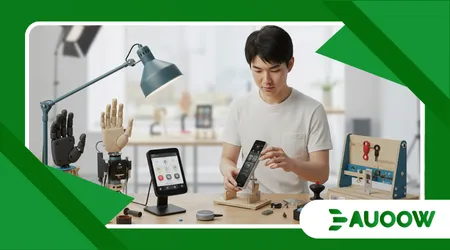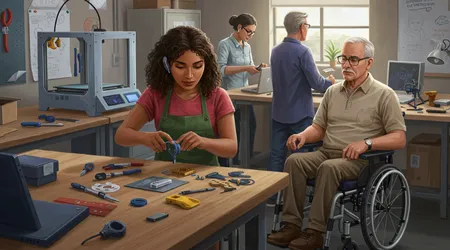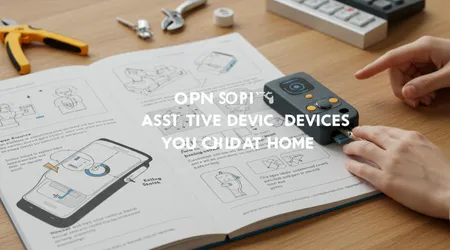Open Source Assistive Devices You Can Build at Home

Open source assistive devices are revolutionizing accessibility, empowering individuals to create tailored solutions for disabilities using affordable, customizable technology.
In 2025, the rise of DIY assistive tech, fueled by collaborative platforms like GitHub and maker communities, is breaking barriers.
This article explores how open source assistive devices enable independence, offering practical examples, real-world impact, and step-by-step insights for building your own.
Why settle for costly proprietary solutions when you can craft personalized tools at home?
The assistive technology landscape is shifting. No longer confined to expensive, mass-produced devices, innovation now thrives in open source ecosystems.
Communities of developers, engineers, and everyday tinkerers share blueprints, code, and tutorials, making accessibility inclusive.
From 3D-printed prosthetics to voice-activated controllers, open source assistive devices are democratizing independence.
According to the World Health Organization, over 2 billion people will rely on assistive technology by 2030, highlighting the urgency of scalable solutions.
This movement isn’t just about tech it’s about empowerment, creativity, and human connection.
The Power of Open Source in Assistive Technology
Imagine a world where anyone with a 3D printer can build a prosthetic hand for under $50. That’s the promise of open source assistive devices.
Platforms like e-NABLE provide free designs for 3D-printed prosthetics, customizable for individual needs.
These aren’t one-size-fits-all; they’re tailored, colorful, and often superhero-themed, delighting users, especially kids. Open source thrives on collaboration, with global contributors refining designs daily.
The ethos of open source is simple: share knowledge, improve lives. Unlike proprietary devices costing thousands, open source assistive devices prioritize affordability.
Take the Flexy-Hand, a 3D-printed prosthetic. Its open source design allows users to tweak finger length or grip strength, ensuring a perfect fit.
++ Inclusive Design: Tech Products That Get It Right
Communities on Reddit and Discord offer real-time support, turning novices into makers. This collaborative spirit fosters rapid innovation, outpacing traditional manufacturers.
Accessibility isn’t just physical it’s financial and creative, too. Open source eliminates gatekeepers, letting users modify designs without corporate approval.
For example, a teenager in Brazil used an open source blueprint to build a wheelchair joystick for her brother, adapting it for his specific tremors.
Such stories highlight how open source assistive devices empower users to solve personal challenges with ingenuity.

Building Your Own Assistive Devices: Where to Start
Diving into open source assistive devices might feel daunting, but it’s surprisingly accessible. Start with a basic 3D printer, costing $200-$500, and free software like Cura.
Platforms like Thingiverse host thousands of designs, from braille embossers to adaptive utensils. Choose a project matching your skill level beginners can start with simple grips, while advanced makers tackle electronics.
You don’t need to be an engineer. Tutorials on YouTube guide you through each step, from downloading files to assembling parts.
For instance, the OpenBraille project offers a DIY braille embosser using affordable microcontrollers.
Communities like Hackaday provide forums to troubleshoot issues, ensuring you’re never alone. The key is starting small and learning as you build.
Also read: The Best Free Assistive Technology Tools for Students with Dyslexia
Safety is critical when crafting open source assistive devices. Always test prototypes for durability and comfort before use. A poorly printed prosthetic could break, causing injury.
Consult online communities for best practices, like using food-safe filaments for utensils. With patience, you’ll transform raw materials into life-changing tools, tailored to specific needs.
Real-World Examples of Open Source Assistive Devices
Consider the GlassOuse, an open source head-tracking device for people with motor disabilities. Its blueprint, available on GitHub, uses sensors to control cursors via head movements.
Users with conditions like ALS can browse the web independently, using affordable components like Arduino boards. This device exemplifies how open source assistive devices prioritize function and freedom.
Another inspiring example is the Open Source Wheelchair Project. Shared on Instructables, it offers plans for a motorized wheelchair built with off-the-shelf parts.
Read more: Robotics in Assistive Care: Innovations to Watch
Costing under $1,000, it’s a fraction of commercial models’ price. Users can customize features, like adding terrain-friendly wheels, proving open source fosters innovation where markets fail.
The DIY community also shines in sensory aids. The Tactile Time project, an open source braille watch, uses 3D-printed components and vibrating motors.
Blind users can feel the time through subtle pulses, blending affordability with elegance. These examples show how open source assistive devices turn ideas into tangible solutions.
Challenges and Solutions in Open Source Assistive Tech

Building open source assistive devices isn’t without hurdles. Access to tools like 3D printers or microcontrollers can be limited in low-income regions.
However, initiatives like Makers Making Change connect users with local makerspaces, offering shared resources. These hubs bridge the gap, making technology accessible to all.
Quality control is another challenge. Unlike commercial devices, DIY projects lack formal testing. To address this, communities like e-NABLE provide rigorous design standards and peer reviews.
Before building, check forums for user feedback to avoid faulty designs. This collaborative vetting ensures open source assistive devices are safe and effective.
Skeptics might ask: Can homemade devices match professional quality? The answer lies in iteration. Open source thrives on constant improvement, with users worldwide refining designs.
By tapping into these evolving resources, makers can create devices rivaling commercial options, often at a fraction of the cost.
The Future of Open Source Assistive Technology
Looking ahead, open source assistive devices are poised to integrate AI and IoT. Imagine a smart cane, like Stanford’s 2021 prototype, using open source AI to navigate obstacles.
Shared on GitHub, its code evolves as developers add features like voice feedback. This fusion of tech promises smarter, adaptive tools.
Sustainability is also key. Google’s 2030 carbon-neutral goal inspires open source projects to use eco-friendly materials, like biodegradable filaments.
Projects like the Open Source Prosthetic Arm now prioritize recycled plastics, reducing environmental impact. This aligns innovation with global sustainability trends, enhancing accessibility’s reach.
Policy changes could amplify impact. Governments, like the UK’s, are investing in assistive tech research, with £4.2 million allocated in 2023 for mental health innovations.
Open source communities can leverage such funding to scale projects, ensuring open source assistive devices reach more users worldwide.
Table: Comparison of Open Source vs. Commercial Assistive Devices
| Feature | Open Source Assistive Devices | Commercial Devices |
|---|---|---|
| Cost | $50-$1,000 | $1,000-$10,000+ |
| Customization | High, user-driven | Limited, proprietary |
| Community Support | Global, collaborative | Limited, brand-specific |
| Accessibility | Freely available designs | Purchase required |
| Innovation Speed | Rapid, iterative | Slower, regulated |
Why Open Source Assistive Devices Matter
Think of open source assistive devices as a digital campfire people gather, share stories, and build something greater together. They’re not just tools; they’re symbols of autonomy.
A 2023 study by Accessibilitychecker.org found 73% of accessible websites saw increased organic traffic after optimizations, proving accessibility boosts visibility. Open source extends this principle, making tech inclusive.
For individuals, the impact is profound. A parent crafting a custom grip for their child’s spoon restores dignity at mealtimes.
These devices aren’t just functional; they’re personal, reflecting the user’s identity. Open source empowers people to reclaim control, turning disability into opportunity through creativity.
The ripple effect is global. In regions with limited healthcare, open source designs fill gaps commercial markets ignore.
By sharing knowledge, we build a world where no one is left behind. Isn’t that the true promise of technology to uplift everyone, everywhere?
Frequently Asked Questions
Q: Are open source assistive devices safe to use?
A: Yes, if built with vetted designs and tested for durability. Always follow community guidelines and consult experts on platforms like Hackaday.
Q: Do I need advanced skills to build these devices?
A: No, many projects are beginner-friendly. Start with simple designs, like 3D-printed grips, and use tutorials to guide you.
Q: Where can I find reliable open source designs?
A: Platforms like Thingiverse, GitHub, and e-NABLE offer trusted designs. Check community reviews to ensure quality and safety.
Q: How can I contribute to open source assistive tech?
A: Share your designs, provide feedback, or join platforms like Makers Making Change to collaborate with global makers.
In 2025, open source assistive devices are more than gadgets they’re a movement. By blending creativity, technology, and community, they redefine accessibility.
Whether you’re a maker or a user, dive in. Build, share, and transform lives, one project at a time.
